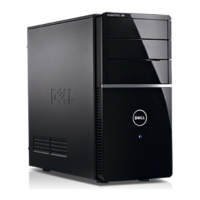Follow these tips when troubleshooting your computer:
If you added or removed a part before the problem started, review the installation procedures and ensure that the part
is correctly installed.
If a peripheral device does not work, ensure that the device is properly connected.
If an error message appears on the screen, write down the exact message. This message may help support personnel
diagnose and fix the problem(s).
If an error message occurs in a program, see the program's documentation.
NOTE: The procedures in this document were written for the Windows default view, so they may not apply if you set
your Dell™ computer to the Windows Classic view.
Battery Problems
CAUTION: There is a danger of a new battery exploding if it is incorrectly installed. Replace the battery
only with the same or equivalent type recommended by the manufacturer. Discard used batteries
according to the manufacturer's instructions.
CAUTION: Before you begin any of the procedures in this section, follow the safety instructions that
shipped with your computer. For additional safety best practices information, see the Regulatory
Compliance Homepage at www.dell.com/regulatory_compliance.
Replace the battery — If you have to repeatedly reset time and date information after turning on the computer, or if an
incorrect time or date displays during start-up, replace the battery (see Coin-Cell Battery
). If the battery still does not work
properly, contact Dell at support.dell.com.
Drive Problems
CAUTION: Before you begin any of the procedures in this section, follow the safety instructions that
shipped with your computer. For additional safety best practices information, see the Regulatory
Compliance Homepage at www.dell.com/regulatory_compliance.
Ensure that Microsoft® Windows
®
Recognizes the drive —
Windows XP:
Click Start and click My Computer.
Windows Vista®:
Click the Windows Vista Start button and click Computer.
If the drive is not listed, perform a full scan with your antivirus software to check for and remove viruses. Viruses can
sometimes prevent Windows from recognizing the drive.
Test the drive — Insert another disc to eliminate the possibility that the original drive is defective.
Clean the drive or disk — See "Cleaning Your Computer" in the Setup and Quick Reference Guide.
Check the cable connections
Run the Hardware Troubleshooter — See Hardware Troubleshooter
.

